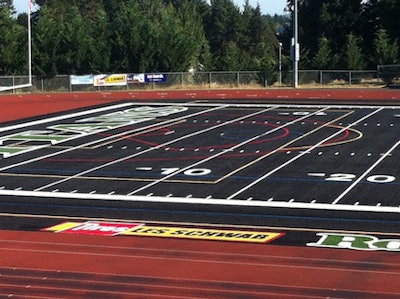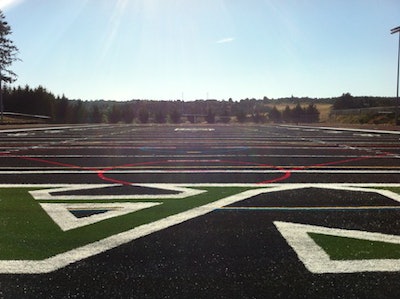In the past five years, we've seen blue turf and red turf installed at high school stadiums - and don't forget about the new candy cane turf at the University of Lindenwood-Belleville. Now, West Salem (Ore.) High School has added to the rainbow of turf colors with what is thought to be the only outdoor black football field in the country - although the Indoor Football League's Nebraska Danger plays on a black field, too. And, following the West Salem field's Friday night debut, it reportedly already has a nickname: "The Black Hole."
According to Salem's Statesman Journal, a group that included West Salem principal Ed John and football coach Shawn Stanley spearheaded a fundraising drive that generated $437,000 - including donations from four major local sponsors whose logos are sewn into the home sideline of the field - to replace the school's worn-out 10-year-old green FieldTurf with black FieldTurf. But because the Montreal-based manufacturer offered a discount if West Salem opted for a nontraditional color, the total price tag was closer to $300,000.
 912_BlackTurf1.jpg
912_BlackTurf1.jpg
But won't surface temperatures on black turf be greater than on green? Yes, but not significantly, according to a "Synthetic Turf Heat Evaluation" published in January by Penn State's Center for Sports Surface Research. That study involved 11 synthetic turf system samples placed under a 250-watt infrared heat lamp for three hours, as well as outdoor evaluations. While green fibers under the lamp reached temperatures between 158.9 degrees and 167.3 degrees Fahrenheit (depending on the type and color of infill), black turf with black rubber infill reached 169.2 degrees - the same as silver-colored turf. White (170.4 degrees) and gold (171.1 degrees) fibers tested even hotter.
When tested outdoors on a clear and sunny Pennsylvania day in June 2011, when the average air temperature between noon and 3 p.m. was 76 degrees Fahrenheit, higher temperatures were recorded for gold (173.4 degrees) and silver (169.1 degrees) turf systems, with the third warmest being the black turf system at 167.3 degrees. The white turf system was among the coolest in outdoors testing at 155.3 degrees.
"The color of the fiber doesn't seem to matter much, especially when combined with infill," Andrew McNitt, a professor of soil science and the director of the Sports Surface Research Center, told AB on Tuesday. "It is the polyethylene itself - mostly independent of color."
"I believe those findings are accurate," says Darren Gill, vice president of global marketing for FieldTurf, which provided most of the fibers that were evaluated.
The only on-field colors at West Salem's new field that aren't black or white are the sewn-in lines for soccer and lacrosse, the green "Titan" script in the end zones and the "WS" at the 50-yard line.
 912_BlackTurf2.jpg
912_BlackTurf2.jpg
































